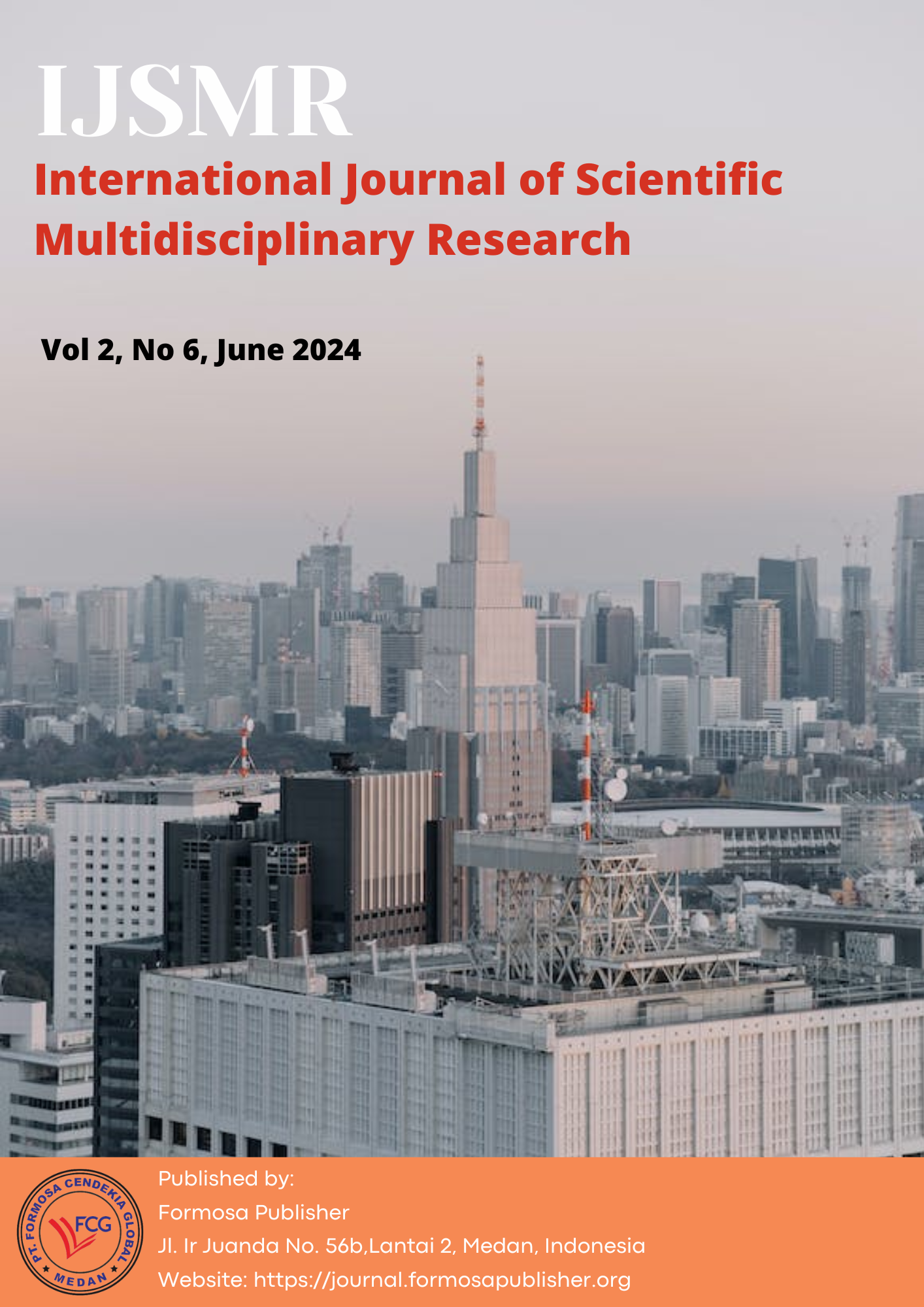Investigating the Effects of Foreign Aid on the Unemployment Level in Afghanistan: Application of the Auto Regressive Distributed Lag Model
DOI:
https://doi.org/10.55927/ijsmr.v2i6.9182Keywords:
Foreign Aid, Unemployment, Auto Regressive Distributed Lag Model, AfghanistanAbstract
The correlation between foreign aid and unemployment rates is a topic extensively debated and examined by development economists and policymakers in developing nations. Therefore, this research was conducted to investigate the relationship between foreign aid and the unemployment rate in Afghanistan from 1990 to 2021 and used Auto Regressive Distributed Lag Model. Results showed that the foreign aid variable (ODA) has a statistically significant negative impact on the unemployment level, as evidenced by a coefficient of -0.014. Consequently, the rise in foreign aid results in declining unemployment rates in Afghanistan. Hence, it can be asserted that the expansion of foreign aid is a viable means to foster employment growth in countries. According to this idea, foreign aid is a possible strategic element for decreasing unemployment
Downloads
References
Addison, T., Mavrotas, G., & McGillivray, M. (2005). Development assistance and development finance: evidence and global policy agendas. Journal of International Development: The Journal of the Development Studies Association, 17(6), 819-836.
AKBAR, M. (2021). The Relationship Between Economic Growth and Foreign Aid: The Case of Afghanistan. Journal of Economic Policy Researches, 8(2), 141-154.
Andaish, M. Q., & Assadi, M. S. (2024). A study on the effectiveness of foreign aid on human development of Afghanistan. Sustainable Technology and Entrepreneurship, 3(1), 100056.
Bawatneh, S. J. (2020). Analytical View on the Impact of Foreign Aid on the Palestinian Local Development within the Framework of the Local Government Sector-Under the State Building Phase. Open Science Journal, 5(1).
Bizhan, N. (2017). Aid paradoxes in Afghanistan: Building and undermining the state. Routledge.
Dickey, D. and W. A. Fuller (1981), “Likelihood Ratio Statistics for Autoregressive time Series with a Unit Root” Econometrica, 49, 1057–1072.
Fayez, H. (2012). The Role of Foreign Aid in Afghanistan's Reconstruction: A Critical Assessment. Economic and Political Weekly, 65-70.
Gomanee, K., Morrissey, O., Mosley, P., & Verschoor, A. (2005). Aid government expenditure, and aggregate welfare. World Development, 33(3), 355–370.
Hakimzai, S. N. (2023). Analyzing female labor force participation in Afghanistan: Panel data approach. Turkish Economic Review, 9(4), 309-323.
IMF (International Monetary Fund) (2020). Government Finance Statistics Database. Online version.
Joya, O. (2011). Macroeconomic instability in Afghanistan: causes and solutions.
Kamguia, B., Tadadjeu, S., Miamo, C., & Njangang, H. (2022). Does foreign aid impede economic complexity in developing countries?. International Economics, 169, 71-88.
Lancaster, C. (2007). Foreign Aid: Diplomacy, Development, Domestic Politics. Chicago: Chicago University Press.
Mbah, S., & Amassoma, D. (2014). The linkage between foreign aid and economic growth in Nigeria. International Journal of Economic Practices and Theories, 4(6), 1007-1017.
Mohamed, M. R., & Mzee, S. S. (2017). Foreign aid and human development: A quantile regression approach. International Journal of Economics Management and Accounting, 25(1), 27–41.
Mohammadinia, M. Z. (2021). FEMALE LABOUR FORCE PARTICIPATION IN AFGHANISTAN: CHANGES, ECONOMIC ACTIVITIES AND DETERMINANTS (Doctoral dissertation, South Asian University).
Murshed, M., & Khanaum, M. M. (2012). Impact of foreign aid in the economic development of recipient country. Journal of the Bangladesh Association of Young Researchers, 33-37.
Nasery, J. A. (2014). The Economic Shock to Afghanistan Caused by Aid Reduction and Troops Withdrawal. Institute of Development Research and Development Policy Working Papers No. 202. Bochum.
Nixon, H. (2007). Aiding the State?: International Assistance and the Statebuilding Paradox in Afghanistan. Universitäts-und Landesbibliothek Sachsen-Anhalt.
Pesaran, M.H., Shin, Y., Smith, R.J., 2001. Bounds testing approaches to the analysis of level relationships. Journal of Applied Econometrics 16, 289–326.
Pesaran, M.H.; Smith, R. Estimating long-run relationships from dynamic heterogeneous panels. J. Econom. 1995, 68, 79–113.
Phillips, P. C. B. and P. Perron (1988), “Testing For a Unit Root in Time Series Regression”. Biometrica, 75, 335–346.
Radelet, S. (2006). A primer on foreign aid. Center for Global Development working paper, (92).
Reci, A. (2014, September). Advantages and disadvantages of foreign assistance in Albania. In Forum Scientiae Oeconomia (Vol. 2, No. 3, pp. 123-132).
Rubin, B. (2002). The Fragmentation of Afghanistan: State Formation and Collapse in the International System (2nd ed.). New Haven: Yale University Press.
Shaiq, M. A., Barati, A. A., Kalantari, K., & Asadi, A. (2022). Dimensions of Poverty in Kunduz Province of Afghanistan. World, 3(4), 979-992.
Shaiq, M. A., Kalantari, K., Asadi, A., & Barati, A. A. (2021). Investigating Afghanistan's Rural Development Challenges and their Solutions. Journal of Rural Research, 12(3), 520-535.
Shaiq, M. A., Aiuby, H., & Hayat, M. (2024). Navigating drought in Kunduz province, Afghanistan: insights from experts’ perspectives. DYSONA-Applied Science, 33-40.
Shirazi, N. S., Mannap, T. A. A., & Ali, M. (2009). Effectiveness of foreign aid and human development. The Pakistan Development Review, 48(4), 853–862.
Sigar (2017) Quarterly Report to the United States Congress, July 30, 2017, www.sigar.mil
Todaro, M., and Smith, S. (2014). Economic Development (12th ed.). New Jersey: Pearson Education, Inc.
Totakhail, M. L. (2011). Foreign Aid and Economic Development in Afghanistan. Unpublished Doctoral dissertation). The University of Erfurt.
Vansiya, Y., Andaish, Q., & Assadi, S. (2022). A STUDY ON IMPACT OF FOREIGN AID ON HUMAN DEVELOPMENT OF ASIAN COUNTRIES: WITH QUANTILE REGRESSION APPROACH. Towards Excellence, 14(4).
Villanthenkodath, M. A., & Mushtaq, U. (2021). Modeling the nexus between foreign aid and economic growth: a case of Afghanistan and Egypt. Studies of Applied Economics, 39(2).
World Bank (2017) Data, www.worldbank.org/data/afghanistan
Yiew, T. H., & Lau, E. (2018). Does foreign aid contribute to or impeded economic growth. Journal of International Studies Vol, 11(3), 21-30.
Downloads
Published
How to Cite
Issue
Section
License
Copyright (c) 2024 Sakhibaksh Assadi, Muhammad Asef Shaiq, Qiamuddin Andaish

This work is licensed under a Creative Commons Attribution 4.0 International License.
















